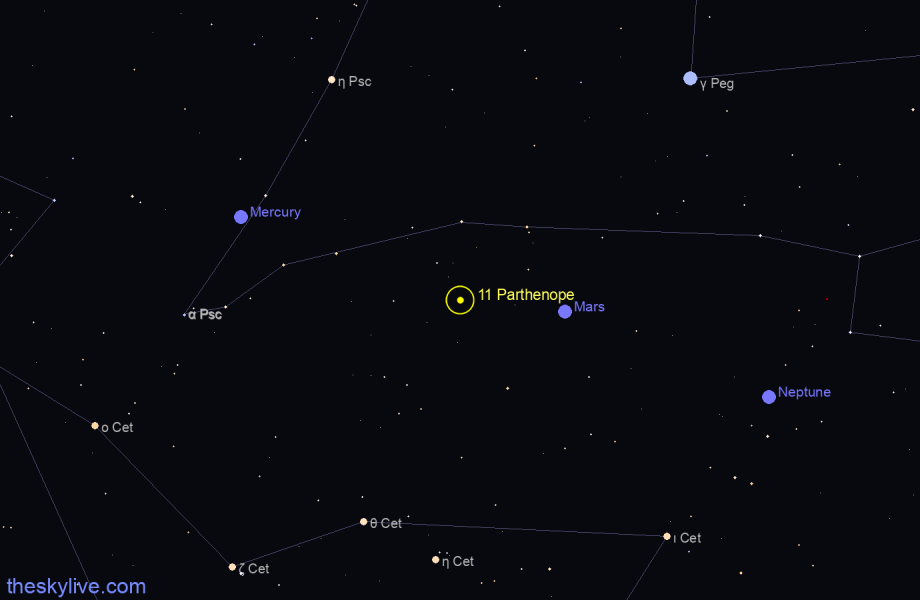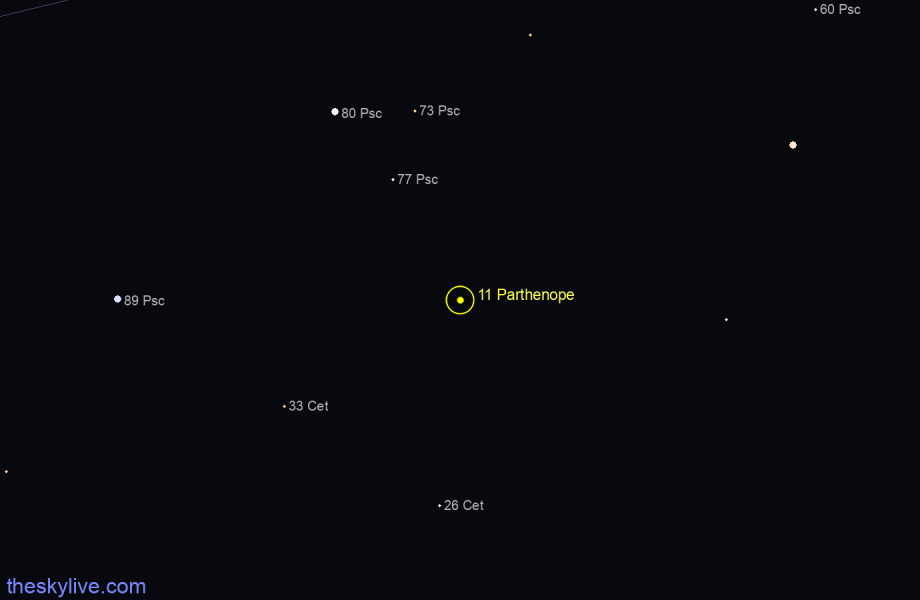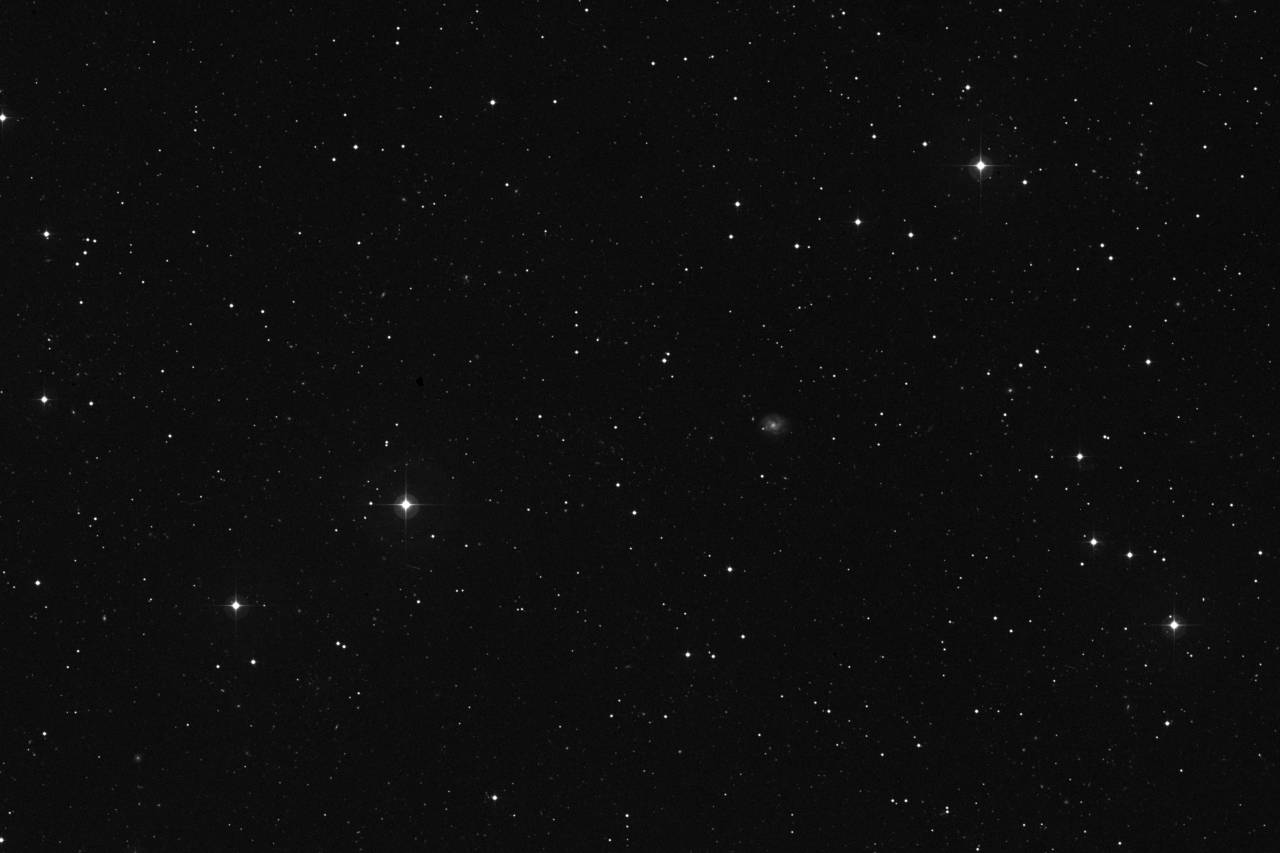Asteroid 11 Parthenope
Asteroid 11 Parthenope is a large, main-belt asteroid with a diameter of approximately 162 kilometers. It was discovered on May 11, 1850, by Italian astronomer Annibale de Gasparis and named after the Siren of Greek mythology, Parthenope. The asteroid orbits the Sun between Mars and Jupiter, with a semi-major axis of approximately 2.45 astronomical units (AU) and an orbital period of about 4.04 years. Parthenope's orbit is relatively eccentric and inclined compared to other asteroids in the main belt. It rotates slowly, with a rotation period of about 16 hours. Parthenope is also classified as a C-type asteroid, indicating that its surface is likely rich in carbonaceous materials.
Asteroid 11 Parthenope is currently in the constellation of Cetus, at a distance of 459,165,299 kilometers from Earth.
View interactive star map
Today's rise, transit and set times of Asteroid 11 Parthenope from Greenwich, United Kingdom (all times relative to the local timezone Europe/London):
- 11 Parthenope is below the horizon from Greenwich, United Kingdom .
- Given its current magnitude, 11 Parthenope is visible with the help of a telescope having an aperture of 4 inches (100mm) or more.
- Go to interactive sky chart
If you need to access this information frequently for your observations, you can create a simple customized Quick Access page, so that you can easily bookmark it in your browser favorites or add a shortcut to your mobile phones' home screen.
Asteroid 11 Parthenope Position and Finder Charts
Field of view: 10x6 degrees
View fullscreen
Higher precision deep sky finder chart, 60 arcmin wide, showing where Asteroid 11 Parthenope is right now. Click on the image to see a more detailed fullscreen tracker view.
Also check out Where is Asteroid 11 Parthenope?, a page that provides all the information needed to find Asteroid 11 Parthenope in the sky and additional links to sky charts.
Asteroid 11 Parthenope Distance from Earth
The distance of Asteroid 11 Parthenope from Earth is currently 459,165,299 kilometers, equivalent to 3.069330 Astronomical Units. Light takes 25 minutes and 31.6106 seconds to travel from Asteroid 11 Parthenope and arrive to us.
The following chart shows the distance of Asteroid 11 Parthenope from Earth as a function of time. In the chart the distance data is measured in Astronomical Units and sampled with an interval of 1 day.
The value of the reported distance might be somewhat inaccurate around the times of closest approach for objects passing extremely close to Earth. The value of the distance of 11 Parthenope from Earth is also available as a real time updated value in the Live Position and Data Tracker.
Closest Approach of Asteroid 11 Parthenope to Earth
Between 1 January 1900 and 31 December 2099, the closest approach of Asteroid 11 Parthenope to Earth happens on Mon Aug 11 2081 at a distance of 1.187050 Astronomical Units, or 177,580,172 kilometers:
NOTE: values for the closest approach are computed with a sampling interval of 1 day.
Asteroid 11 Parthenope Brightness and Light Curve
The following chart is the predicted light curve (visual magnitude as a function of time) of Asteroid 11 Parthenope, according to the most recent ephemerides data. Magnitude data is sampled with a 2 days interval and there might be inaccuracies for objects changing brightness very rapidly during the course of a few days. For comets there could be large discrepancies between the observed and predicted brightness because of their highly dynamic behaviour.
Asteroid 11 Parthenope Orbital Elements
The following table lists the orbital elements of Asteroid 11 Parthenope at epoch 24 February 2023 00:00 UTC (JD: 2460000.5). Source: JPL Small-Body Database
| Element | Symbol | Value |
|---|---|---|
| Orbit eccentricity | e | 0.09941749 |
| Orbit inclination | i | 4.63133416° |
| Perihelion distance | q | 2.20919106 AU 330,490,279 km |
| Aphelion distance | Q |
2.69694697 AU 403,457,525 km |
| Semi-major axis | a |
2.45306902 AU 366,973,902 km |
| Orbital period | period |
3.8421 years 1,403.3406 days |
| Date of perihelion transit | Tp | 2024-Jan-11 04:26:02 2,460,320.6847 JD |
| Next perihelion transit | 2027-Nov-14 12:36 2,461,724.0253 JD |
|
| Argument of perihelion | peri | 195.73724774726° |
| Longitude of the ascending node | node | 125.52086857436° |
| Mean anomaly | M | 277.86276820831° |
| Mean motion | n | 0.25653075°/day |
Visualization of Asteroid 11 Parthenope Orbit
This 3d orbit diagram is a feature of our 3D Solar System Simulator and shows the orbit of Asteroid 11 Parthenope with respect of the Sun and the orbits of the major planets. The position of Asteroid 11 Parthenope and the planets along their orbits in this diagram accurately represents the current configuration of the objects in the Solar System. This is an experimental feature and it requires a WebGL enabled browser. Please provide us feedback!
View Asteroid 11 Parthenope in the 3D Solar System Simulator
Asteroid 11 Parthenope Physical Data
The following shows the known values of the most important physical parameters of Asteroid 11 Parthenope. Source: JPL Small-Body Database
| Physical Parameter | Value | Relative to Earth |
|---|---|---|
| Diameter | 153.33 km | 0.0120 |
| Sideral Rotation | 13.7204 hours | 0.5732 |
| Absolute Magnitude | 6.55 | |
| Geometric Albedo | 0.1803 |
Asteroid 11 Parthenope 15 Days Ephemeris
The following table lists the ephemerides of Asteroid 11 Parthenope computed for the past and next 7 days, with a 24 hours interval. Click on each row of the table to locate Asteroid 11 Parthenope in our Online Planetarium at the chosen date.
| Date | Right AscensionR.A. | DeclinationDec. | MagnitudeMag | Constellation |
|---|---|---|---|---|
| 2024 Apr 18 | 00h 14m 02s | -01° 06’ 26” | 11.63 | Pisces |
| 2024 Apr 19 | 00h 15m 54s | -00° 55’ 22” | 11.63 | Pisces |
| 2024 Apr 20 | 00h 17m 45s | -00° 44’ 17” | 11.64 | Pisces |
| 2024 Apr 21 | 00h 19m 37s | -00° 33’ 15” | 11.64 | Pisces |
| 2024 Apr 22 | 00h 21m 29s | -00° 22’ 15” | 11.65 | Pisces |
| 2024 Apr 23 | 00h 23m 21s | -00° 11’ 17” | 11.65 | Pisces |
| 2024 Apr 24 | 00h 25m 14s | -00° 00’ 20” | 11.66 | Pisces |
| 2024 Apr 25 | 00h 27m 05s | +00° 10’ 32” | 11.66 | Cetus |
| 2024 Apr 26 | 00h 28m 55s | +00° 21’ 24” | 11.67 | Cetus |
| 2024 Apr 27 | 00h 30m 47s | +00° 32’ 14” | 11.67 | Cetus |
| 2024 Apr 28 | 00h 32m 38s | +00° 43’ 04” | 11.67 | Cetus |
| 2024 Apr 29 | 00h 34m 28s | +00° 53’ 49” | 11.68 | Cetus |
| 2024 Apr 30 | 00h 36m 20s | +01° 04’ 33” | 11.68 | Cetus |
| 2024 May 01 | 00h 38m 09s | +01° 15’ 15” | 11.68 | Cetus |





